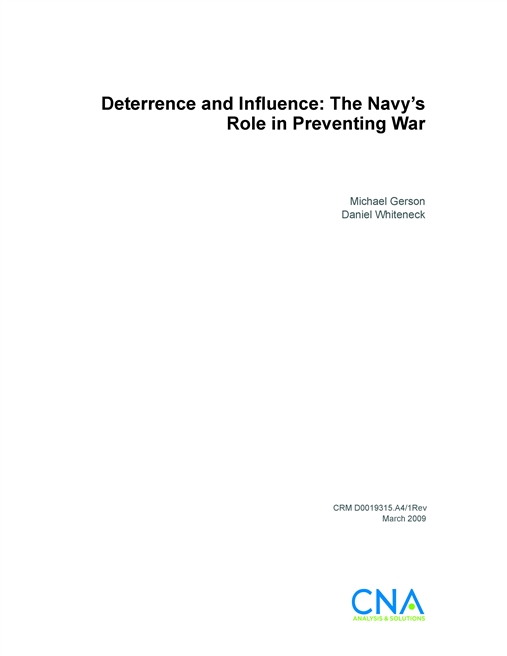A central tenet of the U.S. Navy’s new Maritime Strategy is that preventing wars is as important as winning wars. This emphasis on war prevention has generated new research on maritime contributions to deterrence. OPNAV N51 (Director, Strategy and Policy Division) asked CNA to identify and analyze how maritime capabilities, assets, and operations contribute to conventional deterrence in the cur- rent and emerging international security environment.
Deterrence has always been one of the central strategic principles of war preven- tion. But now, with the end of the Cold War and the rise of a new generation of security challenges, deterrence strategies need to be updated. As Admiral Michael Mullen, the current Chairman of the Joint Chiefs of Staff, recently noted, “It is way past time to reexamine our strategic thinking about deterrence.”
This study examines one aspect of deterrence that has traditionally been overlooked – conventional deterrence. Our objective is to analyze how U.S. non-nuclear capabilities can be used to deter conventional aggression, and to examine the role of maritime power in preventing conventional conflicts.
We address two central questions in this study:
- What are the central concepts and principles of conventional deterrence in the modern international security environment? How does conventional deterrence work?
- What are the unique contributions of maritime power to conventional deterrence?
The relevance of conventional deterrence
In the coming decades, shifts in the balance of global military, economic, and political power may increase the chances of inter-state crises and conflict. In this environment, U.S. conventional power can play an important role in deterring regional aggression.
Compared to U.S. nuclear capabilities, the threat of our conventional power is more likely to be a credible deterrent against conventionally-armed regimes. His- torical and theoretical research suggests that, in general, the possession of nuclear weapons does not provide additional deterrent leverage against states that do not have nuclear (or chemical/biological) weapons. While nuclear weapons may not be a credible threat against non-WMD regimes, the threat of conventional force is highly credible, largely because the United States has overwhelming conventional superiority and a demonstrated willingness to use it.
Conventional deterrence can also play a role against countries that have nuclear weapons. A nuclear-armed adversary may be emboldened to use conventional force against U.S. friends and allies, or to sponsor terrorism, in the belief that its nuclear capabilities provide it with an effective deterrent shield against U.S. retaliation and/or intervention in regional conflicts. In this context, the combination of the forward presence of robust conventional power, coupled with missile defenses and nuclear escalation dominance, can help prevent a regime from believing that its nuclear arsenal provides opportunities for aggression and coercion below the nuclear threshold.
Download reportAPPROVED FOR PUBLIC RELEASE. DISTRIBUTION UNLIMITED.
Details
- Pages: 82
- Document Number: CRM D0019315.A4/1Rev
- Publication Date: 3/1/2009
